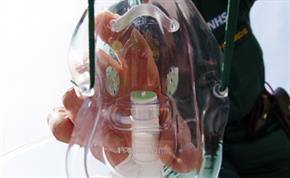This week, we have been promoting respiratory care as part of our winter wise campaign.
In winter, we get a lot of calls to people with breathing problems including children; in January, there were 1,813 calls to EEAST under our ‘breathing problems’ code – and 749 of those were for under 18’s.
Shortness of breath in a paediatric patient can be very distressing for both the child and for the parents/carers, and as such a calm, reassuring and confident approach is vital to alleviate concerns. Be vocal in your treatment plan and clinical thinking and ensure you include those on scene in any treatment plans.
Some of the more common problems we encounter are:
- Asthma: parents will often know their children are asthmatic and it will be very rare to be faced with a presentation of new onset asthma, so a patient should have their own medication to utilise in the treatment plan. Confirm clinical findings and a history to back up the diagnosis of an asthma attack. Encourage the use of the child’s own inhaler, preferably with a spacer if available and give two puffs every two minutes up to five times before escalating treatment if there is no improvement.
Follow the asthma algorithm (see your pocket clinical practice guidelines) and if at any time there are indications of a time critical status, don’t delay transport and treat whilst en-route to the nearest receiving hospital. Consider requesting a paramedic or critical care if available (without delaying transportation with a pre-alert to the nearest receiving emergency department).
- Bronchiolitis: this is a self-limiting respiratory condition that can sometimes last for weeks and is characterised by an inflammation of the bronchioles. It will often present in the very young, under six months old and will be accompanied with coryzal (flu) like symptoms, temperature, cough, wheeze, high respiration rate. The root cause is often viral in nature and as such treatment with antibiotics, and indeed anti-virals, have not been shown to be effective, so the emphasis of treatment is on feeding and ensuring hydration. Any young child with symptoms of bronchiolitis that has had a shortness of breath episode should be transported to a hospital for further assessment. NICE guidance for bronchiolitis gives provision for oxygen supplementation to children only if their oxygen saturation is persistently less than 92%. Salbutamol and ipratropium bromide is also not indicated for these patients.
- Respiratory infections: up to 25% of all children under five years old will present to their GP with chest or upper respiratory tract infections (URTI) each year. In the ambulance service, we see our fair share of these presentations and so should familiarise ourselves with the course of action needed for the different presentations. The biggest assumption is that all children with chest infections will require antibiotics, whereas the reality is given good analgesia, fluids and rest, they will not be necessary, and will often be a last resort for hospitals and GPs reserving them for the worst cases. Whether a URTI or suspected pneumonia, treat the symptoms, gain a thorough history and assess for red flags. Transport to a hospital should only be necessary where there is a reduced fluid intake, due to fatigue or where there is concerns over the diagnosis and an immediate second opinion is required. In most other cases a referral to the GP for further assessment or through the SPOC can be made. Any patient being left at home should receive worsening advice and appropriate safety netting.
During care of paediatric patients, your primary concern must always be for that of the child; before, during and even after treatment. If you have any cause for concern you should seek advice, this can be via the Trust’s Clinical Advice Line, or by talking to the child’s primary care physician. Clinicians must remain vigilant for red flags, ensure that their assessment is thorough and complete, ensuring that this is fully documented along with your working impression, care plan, safety nets and worsening advice.
You can keep up to date with our winter tips by checking out EEAST on Facebook and follow us on Twitter using #winterwise to keep up to date. But what is also vital is your own health and wellbeing - and we’ll be posting regular updates about flu, norovirus and other guidance to ensure everyone is winter wise this season.
Published 18th February, 2016
